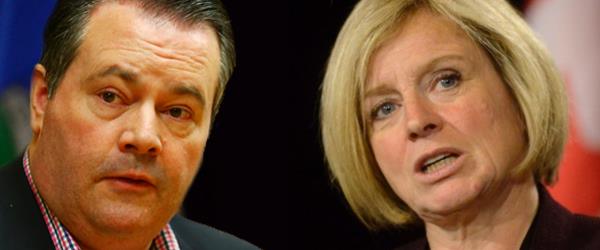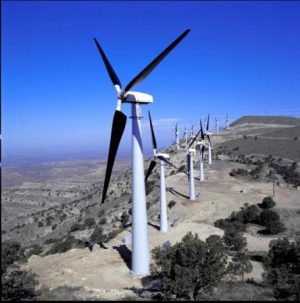California vs. Texas carbon pricing strategies: Notley, Kenney asking Alberta to pick one or the other
NDP policy lines up Albert with emerging Asian markets, UCP approach with existing customers in Texas, Midwest
Yesterday morning I wrote about the carbon tax debate in Alberta, pointing out that Jason Kenney and the UCP were kicking the political stuffing out of Rachel Notley and the NDP on this issue. An afternoon interview with Dr. Fred Beach provided further insight into the public brawl over carbon pricing. He argues there are two basic models for addressing GHG emissions: California (carbon pricing, regulations, subsidies) and Texas (markets, prices, cheaper technology). Notley is championing the former, Kenney the latter, and Albertans are being asked to pick one.
Beach is the assistant director for energy and technology policy at The Energy Institute, University of Texas at Austin. He says the United States has never had an energy policy other than to consume more – because consumption is good and thinks the Trump Administration’s roll back of Democratic President Barack Obama’s many energy transition policies – e.g. the Clean Power Plan to end coal consumption, restriction of oil and gas drilling on federal lands – is just political theatre.
“The economy is what drives us. People want to make money. The market drives them to do the things that help them make money and with technology changes, it’s moving towards cleaner and more efficient energy technologies,” he said.
“I think what we’re seeing happening in the US now is being driven by investments. People who don’t want to be associated with what we would consider higher pollution, higher emission, high CO2 sources. And I think it’s going to be more driven by the market than driven by the government.”
Which brings us to California vs. Texas.
Texas has lowered state greenhouse gas emissions by switching from coal to a combination of cheap shale gas, wind and solar, and a deregulated market. The state with a population (27 million) slightly less than Canada currently gets more than 10 per cent of its electricity from giant wind turbines, many of them on the sparsely populated plains of West Texas. Solar comprises only 0.55 per cent of state power generation, but installations have grown rapidly over the past few years, partly because the excellent solar resource makes even rooftop panels economic in many regions.
“You look at Texas, it’s been primarily about electricity generation with a deregulated market, which is very capitalistic. You get the government out of it,” Beach said.
The Texas model is entirely consistent with Kenney’s carbon tax talking points: consumers pay more, capital is driven out of the Alberta oil and gas industry, thousands of jobs are lost, let markets and industry decide how best to lower emissions.
The United Conservative Party leader says his first bill if he becomes premier will be to scrap the NDP carbon tax.
In California – the home of Elon Musk and Tesla Motors – the focus has been policy driven de-carbonizing of both transportation and power generation.
“California has been more driven from the automotive or the transportation sector with their higher emissions standards for vehicles, which then drives the vehicle industry nation-wide,” he said.
“What California does with regards to vehicle emissions kind of drives the automobile industry in the US.”
Under Gov. Jerry Brown, California has taken an aggressive approach to combating climate change: the California Global Warming Solutions Act that mandates the state to reduce its GHG emissions to 1990 levels by 2020; a clean fuels standard that requires refineries to lower the carbon-intensity of the gasoline and diesel fuels they produce; a cap-and-trade program that’s been in place since 2012; extensive subsidies for electric vehicles and charging infrastructure; more subsidies for solar and wind generation, and market innovations to handle the surplus of electricity created as a result.
The California model looks a lot like Notley’s Climate Leadership Plan: province-wide carbon pricing; coal power generation phase-out and a commitment to replace 30 per cent of provincial power generation with wind and solar; a carbon levy and output-based allocations (Carbon Competitiveness Incentives) combined with a $1.4 billion innovations fund designed to help oil and gas companies lower the carbon-intensity of their production.
Kenney hasn’t tabled his replacement – if any – for the NDP policy, noting that the UCP will be convening soon to determine policy for the new party.
But these are likely the carbon tax options facing Alberta voters between now and the provincial election in 2019: Notley’s carbon pricing, regulations, subsidies vs. Kenney’s markets, pricing, and cheaper technology when it’s ready for widespread adoption.
As I noted yesterday, Kenney appears to be handily winning the public battle over the carbon tax because his message is simple and easily grasped by voters, who recognize their economic self-interest.
By comparison, the Notley message is harder to grasp. De-carbonizing the provincial economy is all fine and well, but why should Alberta care if American competitors aren’t doing the same (which surveys show is a concern of Canadians across the country)?
I suggested yesterday that one message which might resonate with Albertans is that the Notley approach aligns the province with the federal government, the international community, and potential customers like China and India.
Arguing that lowering emissions gives Alberta energy products a competitive advantage in emerging Asian markets – thus attracting investment and creating jobs – could be an effective message. Tie the new strategic direction on carbon pricing to the emerging clean tech industry and technology exports (Alberta is a hotbed of energy innovation), for instance, and the NDP could have a vision that competes with the UCP.
But Kenney has a big head start over Notley on this file. If Notley doesn’t change direction soon, the NDP may as well throw in the towel.










I have been advocating the Texas electricity regulation (and franchise tax)–or the different but equally interesting Massacusetts energy marker regulation models for aost 20 years.
It is crazy that Canadian decision-makers are not looking at the performance of these states and noticing they have done much more a lower cost to ratepayers and taxpayers.
It is frustrating that Canadian academics reflect no knowledge of this ans othe examples of significant history in their modelling or policy positions.
“consumption is good”, government is bad, capitalism is good,… What a lot of drivel. We can’t expect the same jerks that got us into this mess to get us out of it.